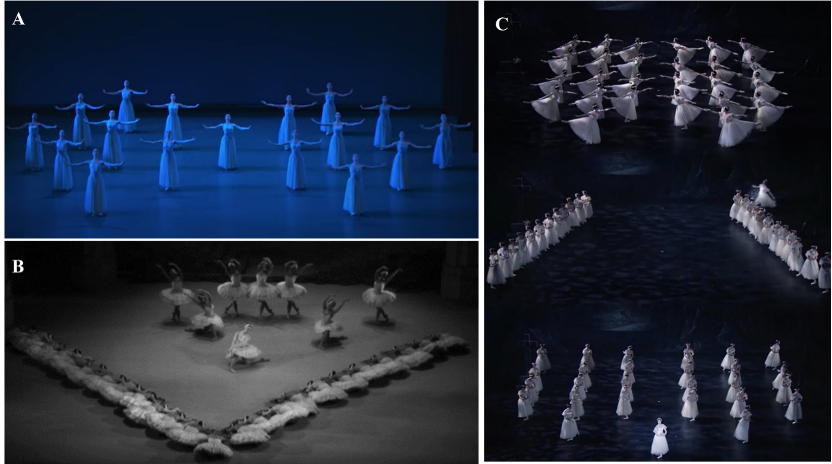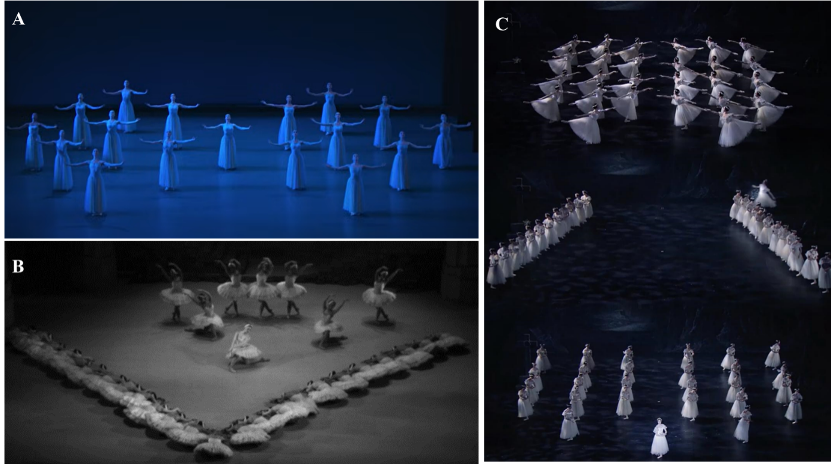Dongyang Yu
The origin of ballet can be traced back to the Italian Renaissance courts of the 15th century. Geometry plays an essential and practical role in ballet, and dancers employ these geometric concepts to ensure precision in their movements, creating visually compelling formations. Geometry is also essential in creating unity, such as synchronization and the formation of shapes, among ballet dancers. (Carman J.) In this article, we will focus on the relevance of geometric principles in ballet techniques and choreography.
Symmetry:
Symmetry, a foundational aspect of ballet for its ability to mirror every dance step, is often used in ballet to create a sense of harmony and balance. George Balanchine often utilized symmetry to organize the space on stage, guiding the audience’s eyes and emphasizing the collective movement of the corps de ballet. The dancers in “Serenade” are placed in such a way that their positions mirror each other, forming geometric patterns that are pleasing to the eye (Figure 1A). This use of symmetry not only adds to the aesthetic appeal but also reinforces the unity of the group, making their movements appear as a cohesive whole rather than as individual performances. The symmetry in “Serenade” is not static but dynamic, evolving as the dancers move through different formations. Symmetry is a great tool for both visual beauty and narrative structure in ballet (Figure 1A).
In Act I of Swan Lake, symmetry is well applied by the corps de ballet (Figure 1B), showing the corps de ballet in a visually striking formation. The dancers are arranged in a V-shape on the stage, with the leading dancer positioned at the point of the V. The symmetry of the arrangement is emphasized by the uniformity of the dancers’ poses and costumes, creating a powerful visual effect. The dancers on the ground, in particular, form a continuous line that adds to the geometric precision of the scene. The use of symmetry and the collective movement of the dancers highlight the discipline and coordination required in classical ballet, contributing to the overall aesthetic beauty of the performance. This use of symmetry enhances the visual appeal of the performance.
Symmetry is skillfully applied in Act x, Giselle. The dancers are arranged in perfect geometric formations, creating a mirror-like effect across the stage. The top image features two symmetrical lines of dancers extending their arms and legs in unison, their movements synchronized to form a balanced, harmonious pattern (Figure 1C). In the middle and bottom images, the dancers are arranged in symmetrical rows, with equal spacing between them, contributing to the overall sense of order and balance. The leading dancer, positioned at the center, serves as the focal point, further emphasizing the symmetrical arrangement (Figure 1C). This use of symmetry not only enhances the visual appeal of the performance but also highlights the precision and discipline required in ballet.
This paper discusses the relationship between ballet and geometric mathematics, especially the symmetry in geometry. However, this study also has some limitations. For instance, the analysis is based primarily on famous popular ballets such as Swan Lake and Giselle, which may not fully represent the diversity of modern or contemporary ballet forms.
Reference:
Carman J. Ballet’s Sacred Geometry: finding meaning within the shapes 2020 [Available from: https://www.dancemagazine.com/ballet-choreography/#gsc.tab=0.
Figure 1:
George Balanchine’s “Serenade”, dancers are arranged to mirror each other’s positions, creating visually appealing geometric patterns (A). In Act I of Swan Lake, the corps de ballet employs symmetry effectively, forming a striking V-shape on stage with the leading dancer at the V’s point (B).


Leave a Reply
You must be logged in to post a comment.